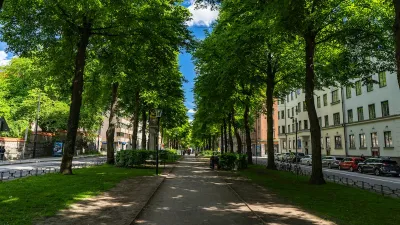A Detroit nonprofit has been planting trees in parts of the city with the lowest tree canopy.

Hadassah Patterson, writing in Next City, reports on a Detroit nonprofit that has been greening the city for over three decades. “The nonprofit has planted over 135,000 trees in the city since 1989, with an increasing focus on low-income or minority areas that were historically redlined. Trees currently cover nearly 23% of formerly redlined (grade D) neighborhoods compared to 43% of formerly greenlined (grade A) neighborhoods in 37 major U.S. cities.”
The article notes that “Greening of Detroit President Lionel Bradford says reforesting can help combat the higher emissions and hotter temperatures that come with urban areas.” According to Bradford, trees also soak up stormwater, preventing water backups that can foster mosquito infestations and other public health threats. “Greening of Detroit partners with the city to determine the best varieties of trees and locations for planting in neighborhoods and parks.”
The tree planting is just one part of Greening of Detroit’s mission. “In addition to employing community members and working with volunteers, Greening of Detroit runs two workforce development programs that are the backbone of their operations,” Patterson writes. “While Greening of Detroit has been working to increase funding streams from their own services, such as selling plants from its nursery, most of its funding comes from grants and donations from the government, foundations, corporations and individuals.”
FULL STORY: Detroit Nonprofit Is Turning Redlined Streets Green

Alabama: Trump Terminates Settlements for Black Communities Harmed By Raw Sewage
Trump deemed the landmark civil rights agreement “illegal DEI and environmental justice policy.”

Planetizen Federal Action Tracker
A weekly monitor of how Trump’s orders and actions are impacting planners and planning in America.

The 120 Year Old Tiny Home Villages That Sheltered San Francisco’s Earthquake Refugees
More than a century ago, San Francisco mobilized to house thousands of residents displaced by the 1906 earthquake. Could their strategy offer a model for the present?

BLM To Rescind Public Lands Rule
The change will downgrade conservation, once again putting federal land at risk for mining and other extractive uses.

Indy Neighborhood Group Builds Temporary Multi-Use Path
Community members, aided in part by funding from the city, repurposed a vehicle lane to create a protected bike and pedestrian path for the summer season.

Congestion Pricing Drops Holland Tunnel Delays by 65 Percent
New York City’s contentious tolling program has yielded improved traffic and roughly $100 million in revenue for the MTA.
Urban Design for Planners 1: Software Tools
This six-course series explores essential urban design concepts using open source software and equips planners with the tools they need to participate fully in the urban design process.
Planning for Universal Design
Learn the tools for implementing Universal Design in planning regulations.
Clanton & Associates, Inc.
Jessamine County Fiscal Court
Institute for Housing and Urban Development Studies (IHS)
City of Grandview
Harvard GSD Executive Education
Toledo-Lucas County Plan Commissions
Salt Lake City
NYU Wagner Graduate School of Public Service





























